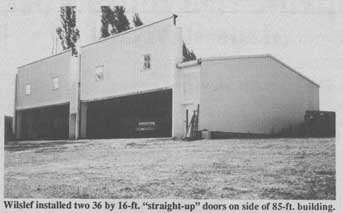
When Jim Cashman of Clarence, Iowa, built his 40 by 60-ft machine shop in 1983, he knew exactly what kind of door he wanted. The ideal door would lift straight up and out of the way with finger-tip controls to provide full opening clearance without sacrificing interior space.
So with the help of Norman "Buster" Wilslef, who operates Wilslef Welding at nearby Wyoming, Iowa, he outfitted it with a solid "high-rise" door 20 ft. wide and 18 ft high. The door is raised and lowered inside a channel frame on both sides by 18-ft. long hydraulic cylinders fed by pressure from a pump with a 5-hp electric motor.
Both Cashman and Wilslef point out that the unique high-rise door is solid and trouble-free. Because the door is set out past the eaves, a big advantage is that it makes a shop seem bigger. Cashman's shop door, built on a frame of 2 by 4-in. metal tubing, is clad on the exterior with 29-gauge steel paneling like the rest of the building.
To open, the door slides up and down in tracks of 1 1/2 by 3-in. channel iron set inside 6 by 18-in. framing channel which is 32 ft. high on each side. A 2-in. dia. pipe holds the two side tracks together at the top. The door is lifted by a pair of 18-ft. shop-built cylinders; a tee in the hydraulic lines allow the cylinders to operate in unison.
"We kept the cost low by using a lot of salvaged material for the framing. The motor for the hydraulic pump came from a used silo unloader." To assemble the cylinders, Wilslef buys only the chrome shafts which have an o-ring on them. Water pipe is used for the outside of the cylinder. He puts the o-ring into a pipe coupler, screws the coupler onto the water pipe, installs a pipe fitting, and fills the pipe with oil.
Wilslef, who has built six high-rise doors for buildings in his area, built the first one for his own shop. "I had priced a big commercial door that would roll back up into the building and it was too much to justify," he says. "So I decided to try out the concept."
Wilslef explains that even if a hose would break on the high-rise door system, the door would come down more slowly. Only about 500 lbs. of pressure is needed to push the door up. For more of a safety factor, he says a check valve can be installed to prevent the door from coming down in case of pressure failure.
